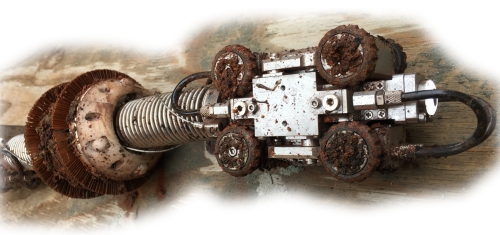Eddy current testing is a widely applied and well-known contactless testing method that is used for non-destructive material testing and material characterisation.
It is based on the physical effect according to that any damage or contamination of electrically conductive materials will result in a change in conductivity or permeability of the tested material. Initially, this type of testing largely resulted from the discovery of electromagnetic induction made by English scientist Michael Faraday in 1831. However, the actual phenomenon of eddy currents was only discovered by French physicist Leon Foucault in 1851, which is why eddy currents are also referred to as Foucault currents.
In the first third of the 20th century, eddy current technology was adapted for the first time for industrial use, and instruments for measuring the conductivity and for sorting mixed iron components were developed.
The principle provides for the arrangement of a primary coil loaded with alternate voltage near an electrically conductive surface. Near-surface circular and symmetric eddy currents are generated vertically to the magnetic flux lines entering the workpiece (primary magnetic field). The thus produced eddy currents, in turn, generate an additional secondary magnetic field that is arranged opposite to the original primary field and weakens the latter. The resulting total magnetic field is then measured by a receive coil. Should there be any material inhomogeneity, the conductivity and thus the induced eddy current will change. This causes a change in the secondary field or respectively the total magnetic field.
Over the years that followed, many new developments in eddy current testing were made, resulting in an improved performance and the development of new applications. The Remote Field Eddy Current (RFEC), which was originally developed in the 1960s for fault testing in oil pipelines, represents a special procedure in eddy current testing.
Easy wall thickness measurement: Not affected by minor contaminations, while measurement through non-conductive coatings is possible. Can be used on iron castings, detects defects in the inner and outer pipe wall
This is a low-frequency testing method in which optimal test frequencies are determined and validated beforehand using reference material with artificially induced comparative defects or natural damage. As a result, it was possible for the first time to penetrate material thicknesses between 10 and 12 mm and to detect major defects. Contrary to the conventional eddy current process, the transmit and the receive coils used in the remote field eddy current process are arranged at significantly larger distances from each other, i.e. the dominant mechanism of the test is through-transmission. During this, the transmit or exciter coil in the pipe generates a magnetic field that travels through the pipe inner wall outward along the pipe. The receive coil is arranged at a distance of approx. 2 to 3 times the pipe diameter away from the transmit coil and will detect the magnetic field that now penetrates the pipe wall for a second time from the outside to the inside. Any areas containing defects will cause a change in the size and phase of the received signal.
The wide range of possible uses and the easy application in combination with the pipe robot technology of INSPECTOR SYSTEMS make it an ideal testing system.
French Paris-based energy supply company and district heating network operator "Compagnie Parisienne de Chauffage Urbain", short CPCU, indicated great interest in the development of such a remote field eddy current inspection robot for inspecting complex pipe systems.
The company uses return steel pipes within a steam network, which are exposed to corrosion due to condensation. Therefore, it carries out routine inspections of individual sections of the more than 500 km long network. CPCU already had experience with the inspection technology on their own pigging tools. However, these cannot be used for travelling the highly complex pipes that include several bends, vertical sections and only one pipe access. Furthermore, the production of the necessary holes in the roads for inserting and removing the inspection pigs in the roads of Paris is a very complex process.
Inspection robots designedby INSPECTOR SYSTEMS equipped with Zetec inspection technology
As a result, the company was looking for a pipe robot system that required little space for inserting the remote field eddy current inspection technology and that should be able to travel through pipes not suitable for inline inspection pigs. Based on these requirements, new inspection robots were designed by INSPECTOR SYSTEMS, which are equipped with the inspection technology of Zetec. Originally designed for pipe diameters of DN 100, future plans also provide for the testing of DN 80 to 300.
The robots were initially tested in dry testing sections inside a hall and subsequently in several route sections in the roads of Paris. The results were convincing in every respect and the findings made during the tests were directly incorporated in the process handling of further tests.



